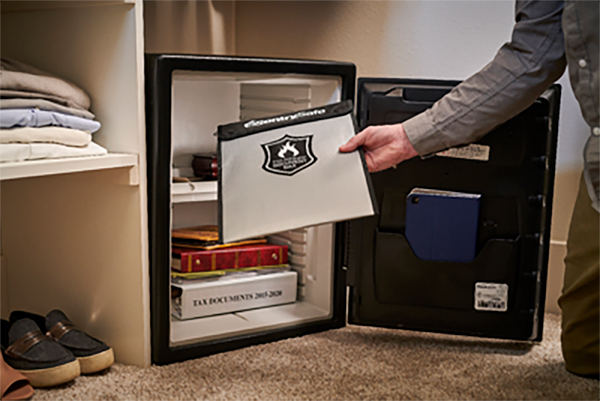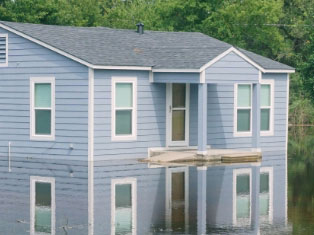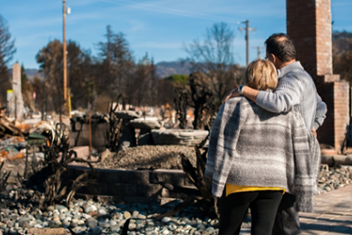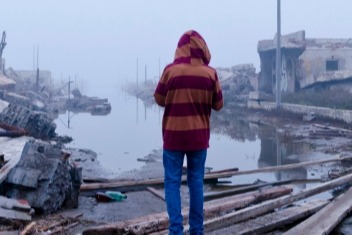- Accueil >
- Security and Safety Insights >
- How to Prevent and Plan for House Fires
How to Prevent and Plan for House Fires

Every 21 seconds, a fire department responds to a fire somewhere in the U.S.1 While these fires lead to billions of dollars in property damage and loss, the human impact is much greater, with thousands of families left without homes and cherished possessions each year. That’s why October is National Fire Prevention Month — a month dedicated to educating homeowners about how to prevent house fires, their most common causes, and how to prepare if one occurs.
What are the most common causes of house fires?
While some fires are started by elements outside your home, like lightning, wildfires or fireworks, most house fires start from within with items you likely use every day. Seemingly minor occurrences like a buildup of lint in your dryer or charging your smart phone on your bed could potentially lead to a fire when you’re least expecting it. Explore some of the fire risks you may have throughout your home and take precautions to better protect your family and property.
Cooking
It likely comes as no surprise that cooking is the number one cause of home fires in the U.S.2 While there are plenty of distractions that can pull you away from your tasks in the kitchen, even just a momentary lapse in your attention could lead to disaster. Ensure that pots and pans on your stovetop aren’t unattended for long, especially if you’re frying or boiling, and keep your cooking surface clear of flammable materials, like kitchen towels, oven mitts and food packaging that can quickly catch flame.
Dryer Lint
Doing laundry is another everyday task that comes with fire risks you may not have considered. Lint builds up in your dryer over time, so it’s important to clean the lint screen either before or after every load and to occasionally check the vent on the outside of your house to ensure it’s venting properly. This will not only help your clothes dry faster, but it will also keep lint from building up in the duct. If you don’t feel warm exhaust through the outside vent, a buildup of lint may be restricting the airflow. Disconnect your dryer and clean the whole duct once a year to prevent a more dangerous blockage.
Heating Equipment
When the temperature starts to drop this winter, it can be tempting to plug in your space heater or electric blanket to make colder rooms more comfortable. However, space heaters are another leading cause of house fires when they’re not used safely. Keep your heater at least three feet away from flammable items and turn it off and unplug it whenever you leave the room. Be sure to put your heater on a flat surface to avoid tipping and keep your children and pets away for their safety.
Candles
While lighting candles is a simple way to create a soothing atmosphere in your home, they can quickly cause a blaze if they’re left unattended, leading to an average of 20 fires a day.3 Before you leave the room, blow out your lit candles and ensure the flames are completely extinguished. If you have children or pets, you may want to consider opting for flameless candles instead to avoid the possibility of toppling an open flame.
Seasonal Fire Risks
The joy of the holidays makes winter a special time of year, and while a crackling fireplace, holiday lights and Christmas trees add festive cheer to your home, they can also lead to a higher fire risk throughout the season. Cleaning your fireplace should be at the top of your winter to-do list since animal nests and creosote can often build up in your chimney plume during the months when it’s not in use. Before you cozy up to your first fire of the season, have a professional clean your chimney so it’s safe to use for the winter ahead.
String lights are a festive way to decorate your home, but some lights are designed exclusively for indoor or outdoor use. Before you start decorating, check to see where your lights are meant to be used. If you have a live Christmas tree decked with lights, it’s important to water it regularly. Dried out trees pose a greater risk to your home since they can ignite and spread a fire within seconds, as opposed to well-watered trees that burn much slower. Keeping your tree a safe distance away from heat sources, like fireplaces, heating vents and candles can also help reduce the risk of a fire in your home.
Take Safety Precautions Throughout Your Home
Just as it’s important to prepare for floods and other natural disasters, it’s crucial to practice preparedness for fires, too. Smoke detectors are a simple, life-saving solution that should be installed in every bedroom, outside every sleeping area and throughout every level of your home. But they’re not the only safety products you should have in your house.
- Purchase a fire extinguisher or extinguishing spray and keep it in a convenient place in your kitchen, like under your sink, to help combat small kitchen fires. It’s also important to review how to operate it correctly, so you’re ready to use it if needed.
- If your home has multiple levels, you should keep a fire escape ladder in every bedroom on the upper level. Review the instructions and practice setting up your ladder so you can quickly deploy it during an emergency.
- Put your important documents in a SentrySafe fire-resistant document bag, which provides basic grab-and-go protection. This will help you save time in an emergency by allowing you to store important documents in one convenient and portable bag.
The last thing you want to worry about during an emergency are the valuables and keepsakes you’ve left behind. Be prepared for anything with a next-generation fireproof safe that’s designed to offer best-in-class protection from fire, water and break-ins. Even if you experience a fire, you can have confidence knowing your fireproof safe is fire resistant for 1 hour in temperatures up to 1700˚F. Plus, it’s also waterproof for up to 24 hours to help protect your valuables from water damage they may sustain from sprinkler systems or fire hoses.
Create A Fire Escape Plan
A house fire can strike at any time, and once your fire alarm sounds, you may have mere minutes to get outside. By creating an escape plan and practicing it with your family, you can help prepare everyone to escape safely.
- Walk through your home to identify all the exit points, including windows and doors. Make sure each window can be opened easily during an emergency.
- Create a map of each level of your home with all the potential exit points. It’s also important to identify who may need additional help escaping, like older adults, children, or those with limited mobility. Make sure to include pets in your plan, as they may need assistance getting out quickly during a fire as well.
- Talk through the escape plan with your children and walk all the potential escape routes. This is also a good time to remind everyone about important fire safety tips, like checking if doors are hot before opening them and staying low to the ground to avoid smoke inhalation.
- Pick a designated meeting point outside of your home where everyone can safely gather and determine who will call 911.
How to Prevent House Fires & Plan for Them: Quick Tips
- Cooking: Never leave your stovetop unattended, especially when frying or boiling, and keep flammable items like towels and oven mitts away from the heat.
- Dryer Lint: Clean your dryer’s lint screen after every load and check the outside vent regularly to ensure proper airflow. Also, clean the duct once a year to prevent dangerous blockages.
- Heating Equipment: Keep space heaters at least three feet away from anything flammable, place them on a flat surface, and turn them off when you leave the room.
- Candles: Always extinguish candles before leaving the room and consider using flameless candles if you have kids or pets to avoid the risk of a fire.
- Seasonal Fire Risks: Before using your fireplace for the winter, have the chimney professionally cleaned. For holiday lights, use them as intended (indoor or outdoor), and regularly water your Christmas tree to prevent it from drying out and becoming a fire hazard.
- Take Precautions & Protect Your Belongings: Install smoke detectors in every bedroom and level of your home and equip yourself with a fire extinguisher and fire escape ladder. Protect important documents and keepsakes with a SentrySafe fire bag and fireproof safe that withstands high temperatures and water damage.
- Create an Escape Plan: Identify all exits, map out routes, consider those who need extra help and designate a safe meeting point outside.
With these tips, products and steps in place, your family will be better protected from potential fire risks in your home, and prepared to escape if a disaster should strike.
Learn more about SentrySafe fireproof safes that can help you protect what matters most.






